| Click On Image For Full Size Image |
Size | Image Description | Contributed By And/Or Copyright |
|
|---|---|---|---|---|
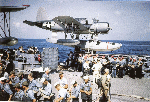 |
271k | The Vought OS2U Kingfisher that appears here on the Missouri (BB-63) shakedown cruise was taken after an abandon ship drill in August 1944. It was one of the most important U.S. floatplanes active in WWII and served with the U.S. Navy, the U.S. Marines and U.S. Coast Guard ( 40 planes for inshore anti-sub patrols) as well as the British Royal Navy ( 100 planes under lend-lease) and the Australian Air Force. This tough little "quarterback", 4800-pound scout observation plane, "the eyes of the fleet", directed concentrated naval gunfire from battleship and cruiser, correcting range and deflection on enemy shores. Kingfishers took part in all major Pacific operations from Pearl Harbor to Tokyo Bay. It tangled with Zero's over the northern area of Iwo Jima and hurled bombs on Attu in the Aleutians and rescued downed or ditched Navy, AAF and Marine pilots in the Pacific and in the Atlantic. For example, after strafing a Japanese-held airfield at Dagua near Wewak, this B-25D of the 405th Bomb Squadron was hit by a Japanese Ki-43 Oscar and turned to sea with a flaming engine to try a water landing. They spotted naval gunfire, bombarding Jap-held islands from the Solomons to Okinawa and worked with PBY Catalina seaplanes and submarines, rescuing pilots undamaged from the carriers that attacked these islands. One Kingfisher from the Baltimore (CA-68), even landed in 1944 on enemy-held territory in Truk Atoll, picking up Lt. (jg.) George Blair, an F6F Hellcat pilot. He autographed a photo, preserved in the Vought Corporation's archives: "Thank God for the Kingfisher. Lt.(jg.) George Blair". Kingfishers assigned to the North Carolina (BB-55) featured in the wildest rescue operations in the Pacific - at Truk, landing in the rough water under gunfire, another on the shores of mainland Japan in the last days of the war. Three Kingfishers combined in 1943 to catch a large Japanese sub. They patrolled in the Atlantic, directing by radio the search for survivors of sunk or damaged vessels. They acted as an ambulance with a removable basket stretcher in the rear cockpit, transporting injured personnel from isolated islands in the Aleutian chain. They dropped smoke pots, bombs and 335-pound depth charges, sending a sub down trailing air bubbles and oil. The Kingfisher had a wingspan of 35 feet eleven inches and a length of 33 feet ten inches. It had a range of more than a thousand miles and a top speed of 170-185 mph. Only 4 of the 1519 OS2U's built by Change Vought Aircraft and the Naval Factory, still exist in the United States. Not all were lost in combat. They were being replaced and scrapped, as this photo taken in Ulithi on 28 December 1944 shows. The end for some nearly undamaged Kingfishers, only missing some minor parts after WWII and left to rot. |
Drawings courtesy of War in Pacific Skies featuring the Aviation Art of Jack Fellows. Zenith Press, St.Paul, MN., 2003 & submitted by Pieter Bakels. Text courtesy of Pieter Bakels. | |
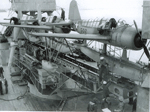 | 202k | Three Kingfishers aboard New York (BB-34) while anchored ar Casco Bay, Maine on 16 June 1943. | USN photo submitted by Pieter Bakels. | |
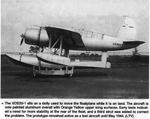 |
103k | Regarding the XOS2U-1: its configuration, painting, and subsequent fleet testing aboard the West Virginia. In Al Adcock's US Navy Floatplanes of World War II in Action he states that the XOS2U-1 was, after being painted blue, repainted to aluminum. | Photograph courtesy of Alan Moore. | |
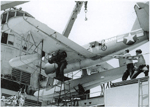 | 242k | OS2U Kingfisher aboard New York (BB-34) in June 1944. Note the depth charge under the port wing. | USN photo submitted by Pieter Bakels. | |
 |
100k | The AN-MK41 with TNT filling. Constructed with flat nose with slight taper from walls to nose. The color and markings were olive drab with a yellow band around nose and base. | Drawing courtesy of "Ammunition Handling"- NavPers 16194- U.S.Government Printing Office," & submitted by Pieter Bakels. Text courtesy of Pieter Bakels. | |
 | 126k | A VO-2 OS2U-3 is lifted off the recovery sled and about to be swung aboard Pennsylvania (BB-38) on 3 August 1943. | USN photo submitted by Pieter Bakels. | |
 | 165k | Hookup for an OS2U-3 #24 aboard Pennsylvania (BB-38) on 3 August 1943. Note that the radiomast is folded down to avoid damage from striking cables. | USN photo submitted by Pieter Bakels. | |
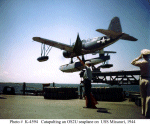 |
68k | With the green flag raised, the catapult crew launches a Vought OS2U floatplane, during the ship's shakedown cruise, circa August 1944. Note liferafts stowed by the catapult. | Official USN photo Naval History and Heritage Command # 80-G-K-4594, now in the collections of the U.S. National Archives. | |
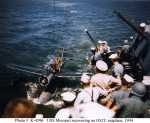 |
94k | Recovering a Vought OS2U Kingfisher floatplane, during the ship's shakedown cruise, circa August 1944. | Official USN photo Naval History and Heritage Command # 80-G-K-4596, now in the collections of the U.S. National Archives. | |
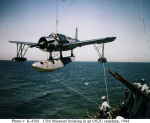 |
73k | Hoisting aboard a Vought OS2U Kingfisher floatplane, during the ship's shakedown cruise, circa August 1944. | Official USN photo Naval History and Heritage Command # 80-G-K-4561, now in the collections of the U.S. National Archives. | |
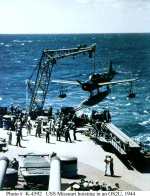 |
107k | A Vought OS2U Kingfisher floatplane is hoisted on board after a flight, during the ship's shakedown cruise, circa August 1944. | Official USN photo Naval History and Heritage Command # 80-G-K-4592, now in the collections of the U.S. National Archives. | |
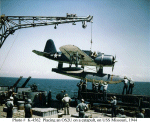 |
85k | A Naval Aircraft Factory OS2N-1 Kingfisher floatplane (Bureau # 01491 or 01401) is lowered onto its catapult cradle after a flight, during the ship's shakedown cruise, circa August 1944. Note Mk.51 director and its associated 40mm quad gun mount at left. | Official USN photo Naval History and Heritage Command # 80-G-K-4562, now in the collections of the U.S. National Archives. | |
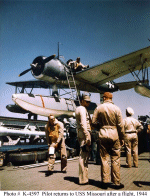 |
98k | The pilot of a Vought OS2U floatplane unstraps his flight log from his leg, after returning from a flight. The airplane is on the catapult behind him. Photographed during the ship's shakedown cruise, circa August 1944. | Official USN photo Naval History and Heritage Command # 80-G-K-4597, now in the collections of the U.S. National Archives. | |
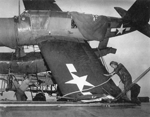 |
140k | Damaged by a typhoon on 19 December 1944. | Photograph courtesy of Brent Jones & submitted by Pieter Bakels. | |
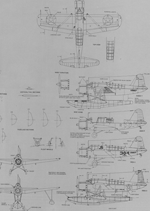 | 3.3m | The Kingfisher in four models: XOS2U-1, OS2U-1/2/ & 3. | Photograph by Art Schoeni, drawn by E.G. Richardson & submitted by Pieter Bakels. | |
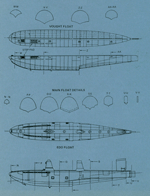 | 2.5m | Main float details for the Kingfisher. | Photograph by Art Schoeni submitted by Pieter Bakels. | |
 | 730k | What's where in the foward part of the Kingfisher. | Photograph by George Lee & submitted by Pieter Bakels. | |
 | 636k | What's where in the rear of the Kingfisher. | Photograph by George Lee & submitted by Pieter Bakels. | |
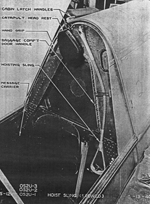 | 1.2m | Cockpit details. | Photograph by George Lee & submitted by Pieter Bakels. | |
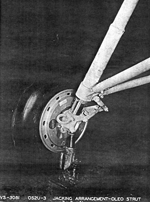 | 1.3m | Jacking arrangement for the OS2U-3. | Photograph by George Lee & submitted by Pieter Bakels. | |
 | 730k | Antenna arrangement for the OS2U-3. | Photograph by George Lee & submitted by Pieter Bakels. | |
 | 1.4m | Instrument panel for the OS2U-3. | Photograph by George Lee & submitted by Pieter Bakels. | |
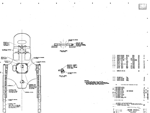 | 666k | Armor installation. | Photograph by George Lee & submitted by Pieter Bakels. | |
 | 866k | Rear cockpit. | Photograph by George Lee & submitted by Pieter Bakels. | |
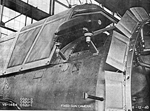 | 2.0m | Fixed gun camera. | Photograph by George Lee & submitted by Pieter Bakels. | |
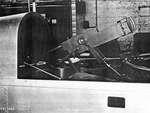 | 1.6m | Flexible gun camera. | Photograph by George Lee & submitted by Pieter Bakels. | |
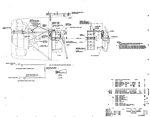 | 801k | Fixed gun installation. | Photograph by George Lee & submitted by Pieter Bakels. | |
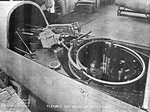 | 2.0m | Flexible gun installation stowed. | Photograph by George Lee & submitted by Pieter Bakels. | |
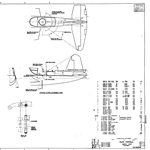 | 2.0m | Angles of fire for flexible gun. | Photograph by George Lee & submitted by Pieter Bakels. | |
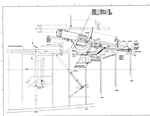 | 1.1m | Mount and seat assembly. | Photograph by George Lee & submitted by Pieter Bakels. | |
 | 964k | Instrument installation. | Photograph by George Lee & submitted by Pieter Bakels. | |
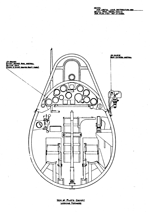 | 533k | View of pilot's cockpit looking forward. | Photograph by George Lee & submitted by Pieter Bakels. | |
 | 1.1m | Antenna installation. | Photograph by George Lee & submitted by Pieter Bakels. | |
 | 1.2m | Instrument installation. | Photograph by George Lee & submitted by Pieter Bakels. | |
 | 942k | Radio installation. | Photograph by George Lee & submitted by Pieter Bakels. | |
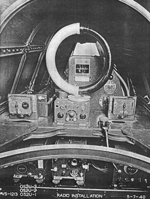 | 1.8m | Radio installation. | Photograph by George Lee & submitted by Pieter Bakels. | |
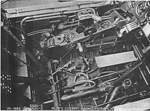 | 1.3m | Pilot's cockpit installation, left hand side. | Photograph by Art Schoeni submitted by Pieter Bakels. | |
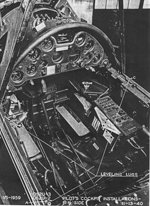 | 2.2m | Pilot's cockpit installation, right hand side. | Photograph by George Lee & submitted by Pieter Bakels. | |
 | 3.8m | Engine. | Photograph by George Lee & submitted by Pieter Bakels. | |
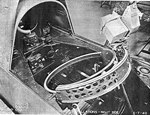 | 2.0m | Rear cockpit installation, right side. | Photograph by George Lee & submitted by Pieter Bakels. | |
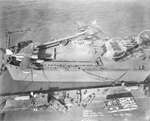 | 983k | Good view of two Vought OS2Us perched aboard Mobile (CL-63) while undergoing refit and repairs at Mare Island, CA., 18 July 1943. | USN photograph # 5208-43 submitted by Pieter Bakels. | |
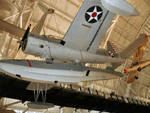 | 195k | Vought OS2Us on display at the Udvar-Hazy annex of the National Air & Space Museum. | Photograph by Pieter Bakels. | |
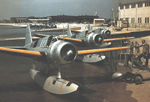 | 285k | Vought OS2U on display at the Udvar-Hazy annex of the National Air & Space Museum. | Photograph by Pieter Bakels. | |
 |
493k | PDF article entitled "Old Slow & Ugly. Article appeared in Air & Space Magazine, Feb / March 2005. | Photo & article courtesy of Pieter Bakels. | |
| Back To US Battleship Construction Index | Back To The Main Photo Index | Back To The Battleship Photo Index Page |
This page is created by Pieter Bakels and Michael Mohl & maintained by Michael Mohl
All Pages © 1996 - 2025, by Paul R. Yarnall NavSource Naval History. All Rights Reserved.